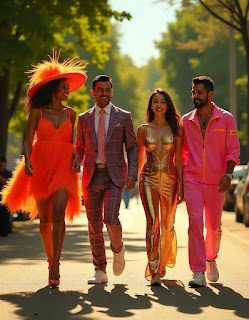Fashion Model
Introduction
Fashion models are individuals who showcase clothing and accessories by wearing them and posing for photographs or walking the runway. They play a vital role in the fashion industry, bringing designers' creations to life and setting trends for the public. Models work with photographers, fashion designers, makeup artists, and stylists to achieve the desired look for various campaigns, fashion shows, and advertisements. Their work can be glamorous but also demands professionalism, discipline, and a commitment to maintaining a certain physical appearance. This profession requires not just beauty, but also the ability to express emotions and tell a story through poses and expressions.
The Role of a Fashion Model
Fashion models are central to the fashion industry. Their primary role is to display clothing and accessories, making them appealing to consumers. They do this through various mediums such as photo shoots, runway shows, and advertising campaigns. Models work closely with designers to showcase new collections. They must understand the vision of the designer and convey it through their movements and expressions. Their job also involves a lot of travel and long hours. Despite the glamorous appearance, it requires hard work and dedication. Being a fashion model means maintaining a certain physical standard, which often includes staying fit and adhering to a strict diet.
Skills and Attributes Needed
To be successful, a fashion model needs more than just good looks. They must have excellent physical condition and the ability to maintain their appearance. Confidence and a strong sense of self are crucial, as models are constantly in the public eye and subject to scrutiny. They need to be comfortable in front of the camera and on the runway, which requires poise and grace. Communication skills are also important, as models must often follow complex instructions from photographers and directors. Flexibility and adaptability are key, as each shoot or show can present different challenges. Lastly, a good work ethic and professionalism are essential.
Types of Fashion Modeling
There are several types of fashion modeling, each with its own requirements and opportunities. Runway modeling involves walking the catwalk during fashion shows, showcasing designers' latest collections. Print modeling focuses on photography for magazines, catalogs, and advertisements. High-fashion models often work in both runway and print and are known for their unique looks and ability to convey high-end fashion. Commercial models, on the other hand, appear in everyday advertisements and promotions, requiring a more relatable look. Plus-size modeling is a growing field that celebrates body diversity. Each type offers different experiences and challenges, but all contribute to the dynamic world of fashion.
The Life of a Fashion Model
The life of a fashion model is often perceived as glamorous, filled with travel, fame, and high-end fashion. While these elements are part of the job, there is also a lot of hard work and discipline involved. Models often have early mornings and long days filled with casting calls, fittings, and photo shoots. They travel frequently, sometimes spending weeks away from home. Maintaining their appearance requires a strict diet, regular exercise, and often dealing with physical and mental stress. Despite the challenges, many models find the work rewarding, as it allows them to express creativity, meet interesting people, and be part of the exciting world of fashion.
Challenges in the Fashion Industry
The fashion industry can be highly competitive and demanding. Models face constant pressure to maintain their appearance and often have to deal with rejection. The industry's standards can also be harsh, sometimes leading to issues such as eating disorders or low self-esteem. The lifestyle can be unpredictable, with irregular work schedules and frequent travel. Additionally, models must protect themselves against exploitation, ensuring they work with reputable agencies and professionals. Despite these challenges, many models find ways to thrive by staying resilient, continuously improving their skills, and finding supportive networks within the industry.
Conclusion
Fashion models are more than just faces that grace magazines or walk the runways. They are essential storytellers in the fashion industry, bringing designers' visions to life. While the profession is demanding and competitive, it also offers unique rewards and opportunities for those who are passionate about fashion and modeling. Aspiring models should be prepared to work hard, stay professional, and maintain their physical and mental well-being. With the right skills and attributes, they can succeed in this dynamic and ever-evolving field.
FAQs
1. What qualifications do you need to be a fashion model?
You don't need formal qualifications, but you do need a good physical condition, confidence, and the ability to pose and walk gracefully.
2. How do models maintain their appearance?
Models usually follow strict diets, exercise regularly, and adhere to skincare and beauty routines to maintain their appearance.
3. Is the life of a fashion model always glamorous?
While there are glamorous aspects, modeling also involves hard work, long hours, and maintaining a disciplined lifestyle.
4. What is the most challenging part of being a fashion model?
The most challenging part can be the constant pressure to maintain appearance and dealing with rejection and competition in the industry.
5. Can anyone become a fashion model?
While anyone can pursue modeling, success often depends on meeting certain physical standards and having the right attributes and skills.






Comments
Post a Comment